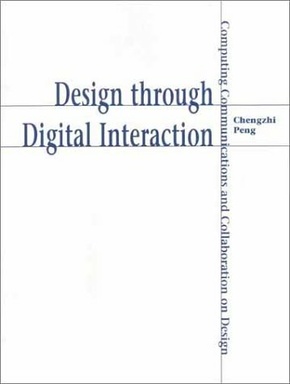Design through Digital Interaction (Book)
Computing, Communication and Collaboration in Design
The times when architects and other designers embarked on the solitary process of developing a design are long gone. Their work has been radically effected by new advances in Information Technology, which are now allowing individuals from very different disciplines to work collaboratively to develop new projects.
This book provides an introduction to this emerging field of Computer Supported Collaborative Design (CSCD), presenting a survey of recent experiments in computer-supported collaborative drawing and design activities, and assessing their implications.
The studies explore teamwork in building design, where team members collaborate to achieve a coherent architectural whole. The book shows that some kinds of flexible generic frameworks or emergent common metaphors can be employed to sustain group dynamism in design through a project's lifetime.
Digital networking is the foundation for the development of all CSCD applications. This book presents a basic typology of networking upon which collaborative computing systems can be built and operated and is the first book to meet the subject matter as a whole in a single coherent volume.
Edition
Figures v
Tables ix
Acknowledgements x
Preface xi
1 From CAD to CSCD: An Introduction 1
Some milestones of architectural CAD (l960s-l 990s). CSCW: A social-technological perspective of practical computing. CSCD: A newly emerging paradigm of CMD? Basic issues raised by architectural design. Design as modelling complex objects. Observing and interpreting case histories. Approaches to research on CMD. Scope and organisation of the book
2 Early Experiments in Supporting Collaborative Drawing and Design 19
Introduction. Aspects of studying group drawing and design activities. Prototype developments and system features. Group uses of shared drawing spaces. Conclusions and pointers to further study
3 Collaborative Design and Shared Discovery of Metaphors 49
Studying how designers work as teams. Communicating space-conception in design: some case histories. Shared discovery of metaphors: A bottom-up scenario. A situation-theoretical framework of description. Bottom-up flow of information in collaborative design
4 More on the Emergence of Common Images and Metaphors 75
Constraints on collaboration in the bottom-up scenario. Issues in supporting emergence of common metaphors. World Wide Web and collaborative design by discovery. Intranet and Web technologies for building TeamCAD
5 Flexible Generic Frameworks and Collaborative Design 93
Flexible generic frameworks: some case histories. From wholes to parts: A topdown scenario of collaborative design. Top-down flow of information in collaborative design. Regarding the Dutch architectural structuralism
6 Joint Substantiation of Common Generic Structures 117
Constraints on sharing flexible generic frameworks. Issues in supporting joint design substantiation. Constraint-based graphics and other related research. GAUDI: A proposed system framework. Operations, images, and collaboration
7 Current Industrial CAD Platforms for Team Working 139
ArchiCAD for TeamWork. AutoCAD 2000i. MicroStation/J and ProjectBank. XML-based schemas for pan-industrial information exchanges
8 Futures of Groupware for Collaborative Design 161
Toward a hypermedia case bank for design studies. Project-wide networking and online architectural services. Innovative interface technologies for collaborative design. Software agents as parts of a project team. Groupware technologies and design education
Glossary 193
Notes 195
References 199
Sources and Illustration Credits 207
Index 209




